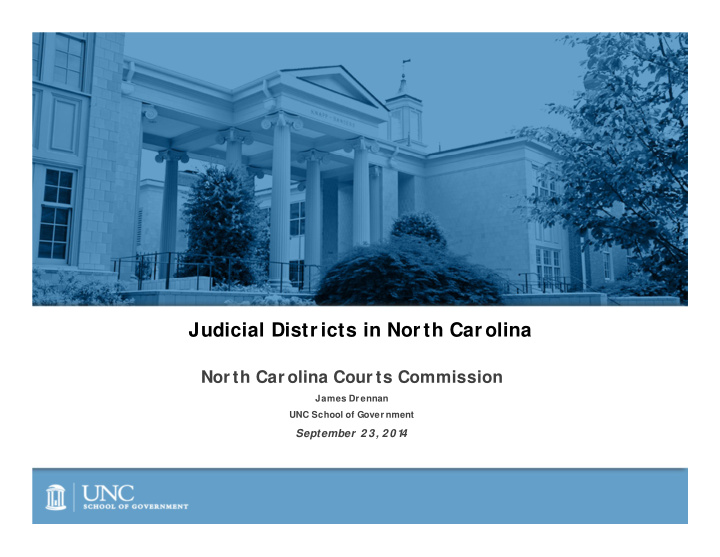



Judicial Distr icts in Nor th Car olina Nor th Car olina Cour ts Commission James Dr ennan UNC School of Gover nment September 2 3, 2 01 4
Judicial Districts--NC Constitution, Art. IV “ The General Assembly shall, from time to time, divide the state into a convenient number of superior court judicial districts. “ The General Assembly shall, from time to time, divide the state into a convenient number of local court districts and shall prescribe where the district courts shall sit. The General Assembly shall, from time to time, divide the state into a convenient number of prosecutorial districts
History—Before Court Reform One superior court judge per district, 1868 1868—12 districts 1875—9 districts 1901—16 districts 1913—20 districts 1937—21 districts 1950—Constitutional amendment to allow more than one judge per district 1955—30 (2 judges in M ecklenburg and Guilford)
Judicial Districts, 1955-2015 1955--Thirty for superior court; in 1967, for all purposes – Six one-county districts, two seven-county districts 2015 – Superior Court--70 for elections, 50 for administration – District Court—44 for elections, 41 for administration – District Attorneys—44 for all purposes – 24 one-county S.Ct. districts; two seven-county Dist. Ct. and DA districts
Judicial Districts, 1960-2010 1960 – Largest--272,000 (M ecklenburg) – Smallest--73,000 (1st, 6th, and 24th) – Ratio--4/ 1 – Average size--151,871 2010 – Largest-969,000 (26th); 952,000 (10th) – Smallest—62,500 (9A); 60,500 (20A) – Ratio--16/ 1 – Average size—222,000 (DA/ District Court); 195,000 (Superior Court)
Districting M ilestones 1950—allowing more than one judge per district 1955—thirty district plan adopted 1965—district court added to superior court districts 1969—prosecutorial districts added to superior court districts 1975—first district split (Gaston, Lincoln, Cleveland)—DA only 1977—district splits in Orange, Chatham and Alamance and applicable to all three levels
M ilestones 1980-90’s 1981, 1987, 1991—district split for Craven, Carteret, Pitt and Pamlico done in three separate stages 1987—redistricting for voting rights compliance; introduction of electoral districts and “sets of districts” 1987—one county moved from one district to another (Hoke from 12 to 16) 1989—dividing of district previously divided (19A— Cabarrus and Rowan into 19A—Cabarrus and 19C—Rowan) 1993—new district from parts of two existing districts (9A—Caswell and Person, from remaining districts 17A and 9) 1995—district court district divided into electoral districts only (9 and 9B---Franklin, Granville, Vance and Franklin)
M ilestones—2000 to present 2001—existing sets of districts redrawn in Wake and Guilford 2001—residency requirement for district court candidates established (Johnston, Harnett and Lee) 2006—residency district for Union repealed, and in 2007, reinstated for a new district in that county 2011—superior court districts redrawn to comply with Blankenship v. Bartlett, one person, one vote NC Supreme Court decision 2013—reversal of district split for district court and DA only, Halifax, Bertie, Northhampton,, and Hertford)
Judicial Districts 32 districts have coterminous lines for all three functions (excluding sets of districts) Seven district court and district attorney districts comprise two superior court districts (Districts 4, 6, 7, 8, 11, 25, 30) One superior court and district court district – 16A—served by two prosecutors 16A and 16C Five districts have the same boundaries for the same purposes as in 1965 (1, 2, 23, 24, 28,)
County with most movement--M oore 1970—District 20 for all purposes 1987—District 20A for superior court, others in District 20 1995—M oved to District 19B for all purposes 1999—Sub-districts (19B1 and 19B2) established for superior court elections, each composed of part of M oore, M ontgomery and Randolph 2003—M oved to new district 19D for superior court 2006—M oved to new district 19D for DA
Judicial Districts Districts have been split Divided and rearranged with parts of other districts to form new districts (9A, 16A) Portions of one district have been moved to other districts (M oore from 20 to 19B) Divided into subdistricts for electoral purposes only, within a county Divided into subdistricts for electoral purposes only, using parts of two or more counties
District Realignments To set up a new district (by subdividing a district into two new districts), the state must, at a minimum, have – a chief district court judge (by adding a new position or upgrading an existing judgeship) • support staff, GAL district administrator, chief court counselor, district Probation officer, etc – a senior resident superior court judge (ditto) – a district attorney (usually a completely new position) and required staff (administrative assistant) To consolidate districts, must do the reverse and eliminate one of each position
Factors Ways to add judicial resources Population Caseload Geography Desire for local influence Facilities Establish minority/ majority districts
District Court Districts Effective January 1, 2015
2013 Budget Changes to District Court Districts
Superior Court Districts Effective 1-1-2-14
2013 Budget Changes to Superior Court Districts and Divisions
Prosecutorial Districts Effective 1-1-2015
2013 Budget Changes to Prosecutorial Districts
Recommend
More recommend